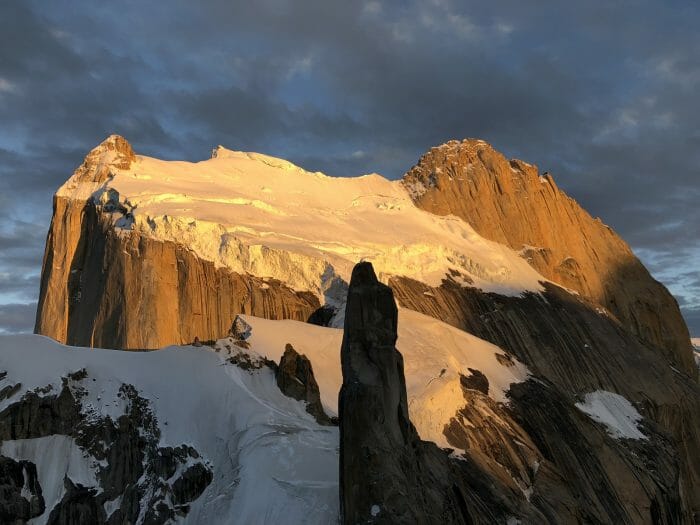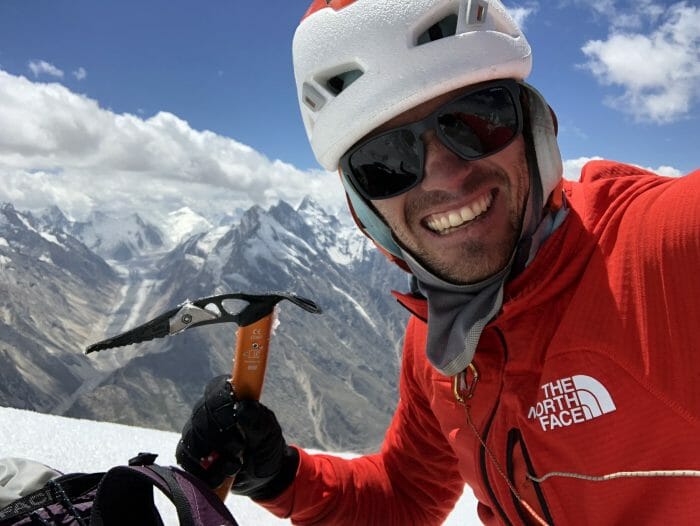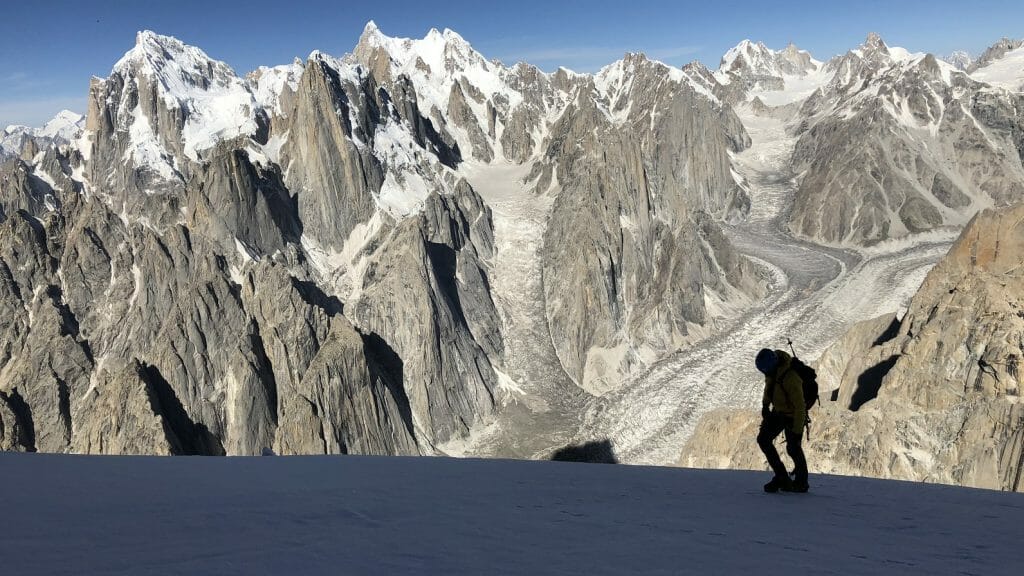My recent solo of the Great Trango Tower isn’t the biggest or most difficult thing I have done, but it is the most meaningful. I climb without a rope all the time around Colorado, and I have climbed mountains by myself, but for me soloing Great Trango Tower represents the next level: a 20,000-foot mountain in the middle of Pakistan, and I was up there by myself. I came back to base camp and came down from my high, and I realized the magnitude of what I had done. I had an alone moment on a huge mountain in the Karakoram. It’s hard to put into words.
I’m not a naturally gifted athlete. I have always had to train and keep to a routine to see gains in my climbing. Four years ago, I decided to retire from the ice climbing World Cup circuit and shift to doing more big mountains and expeditions. I knew I would need to work on my aerobic endurance in order to be more efficient up high.
Steve House is a dear friend of mine, and we climb together all the time. I’d already been picking his brain about training and how to improve when he and Scott Johnston launched Uphill Athlete. I began working with Scott, following a series of 8-week custom plans. Then earlier this year, I moved to working one-on-one with coach Carolyn Parker. I have known Carolyn for many years, from guiding and skiing, so it has been wonderful to reconnect with her on this level.

For my latest expedition, a North Face–sponsored trip to the Trango Towers in Pakistan, Carolyn got me ready with a lot of vertical, a lot of aerobic base training, a lot of rock climbing, and a lot of time at altitude. She told me what to do, and I did it. Having a full-time coach, it’s crazy the improvements I have seen. It’s night and day. All those mornings where I woke up early to walk really slowly uphill paid off in a big way when I reached the towers.
My teammates on the expedition were fellow North Face athletes Anna Pfaff, who spearheaded the trip (and trains with Steve), and David Allfrey. Our plan was to climb the Great Trango Tower via the 1984 American Route and the Trango Tower (Nameless Tower) via Eternal Flame—one of the biggest rock faces in the world, and our main objective for the trip.

I had climbed big walls before—in Zion and Yosemite—but never as the primary objective of an expedition. Usually my expeditions take me to high-altitude alpine faces in places people have never been before. They’re exploratory, often involving more snow and ice climbing than rock climbing. The fact that we were doing an existing route definitely took a bit of the edge off the whole experience. It was refreshing knowing there would be an established path to follow, and that given our collective skill level, we’d most likely get to the top.
We used the Great Trango Tower to acclimatize, then after a couple days in high camp, we pushed up the 20,500-foot-tall Trango Tower. Eternal Flame, perhaps one of the most famous routes on that formation, is a huge climb—like climbing El Capitan and a little bit more. It was on the journey between the two towers that this crazy idea started growing in my mind, becoming more and more insistent: What if I climbed the American Route on the Great Trango Tower alone and in a single push, base camp to base camp? It would be about 14,000 feet of elevation change in one day, involving a fair amount of technical climbing on a remote peak in Pakistan. The idea grew in me like a challenge. There were a whole bunch of question marks, but my curiosity and my confidence in my fitness outpaced the doubts and fear. I was recovering well after Eternal Flame, and I had energy in the tank. I decided to go for it. Something of this magnitude, a climb that would have been out of the realm of possibility three years ago, suddenly seemed within reach, like the odds had tipped in my favor.
One week after we climbed the American Route as a threesome, I left base camp super early and with minimal gear, promising Anna and David I’d keep in touch via radio. The conditions were icier on Great Trango than they had been our first time up. Where before I was able to walk sideways or high-step, I now needed to front-point. With thousands of feet of air under my heels, I had to stay focused the entire time. One mistake and I would be toast. To bring my anxiety down, I zeroed in on the basics: I monitored my heart rate, trying to stay aerobic, and I ate when I needed to and drank as much water as possible. My focus narrowed to accomplishing the day’s goal, one step at a time.

I went from 13,000 feet to 17,500 feet, where our previous high camp was and where the true climbing began, up through rock bands, ice, and snow. I was still feeling pretty good when I reached the summit. K2, Broad Peak, and Masherbrum dominated the mountains spread out in front of me, and when I turned around, there was this different landscape of massive big walls, some of the most iconic in the world. I was surrounded by one of the most majestic views nature has to offer.
Once I’d taken it all in, I began my descent, a mix of rappelling and tenuous downclimbing. I lost time when I kept getting my small-diameter rope stuck in naked V-threads, at one point having to reclimb a pitch to free the rope. These small snafus slowed me down, but fortunately they were the extent of it. When you feel really good physically, you feel really good mentally as well. You have extra energy to deal with the annoyances—the little things that can take a gradual toll on you if you aren’t as fit or well prepared.
I made it back to base camp in one piece. The entire climb took me 11 hours, 38 minutes, which is extremely fast for a route like that. I let my adrenaline go down and let the experience soak in. This adventure, and the training it took to make it possible, opened my eyes and my world to a new range of opportunities and desires. I’m already dreaming of future projects I can do in a similar style. I’m stoked to resume my training because I have seen that if you put the time in, the sky’s the limit. I emerged with a different mindset.
-by Uphill Athlete Andres Marin

